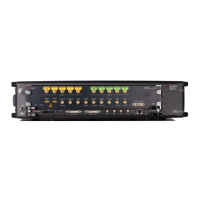The two channels have the following input fields.
Mode
Selects the waveform output modes. Available selections depend on the selection
made by the direct/interpolated radio buttons. Direct mode: 12 bit, 14 bit.
Interpolated mode: INTX3/12/24/48.
WSPeed: Speed mode, 12 bit DAC resolution
WPRecision: Precision mode, 14 bit DAC resolution
INTX3: Interpolation x3 mode
INTX12: Interpolation x12 mode
INTX24: Interpolation x24 mode
INTX48: Interpolation x48 mode
The interpolated modes INTX3, INTX12, INTX24 and INTX48 are only available
when the DUC option is installed.
DAC format mode
Selects among the DAC Format Modes. Internally two DACs are used
(A, B). Each usually contributes to signal 50% of a sample period.
RZ: DAC A sends value for whole sample period.
DNRZ: DAC A and B send same value.
NRZ: DAC A sends value for whole sample period.
DOUBlet: DAC A sends +Value, DAC B sends –Value
For more details on the DAC format modes, refer to the section “Dual-Core DAC
Architectures” in the Fundamentals of Arbitrary Waveform Generation Reference
Guide (Manual Part No. M8190-91050).
Direct/Interpolated radio buttons
Switch between interpolated and direct modes. The interpolated modes INTX3,
INTX12, INTX24 and INTX48 are only available when the DUC option is installed.
Direct mode = no DUC mode
Interpolated mode = DUC mode
In the Interpolated mode we have the NCO generated carrier signal and the
baseband signal (the generated IQ waveforms of the various panels). The carrier
frequency (aka center frequency) is only used in DUC mode and is the frequency at
which the NCO runs. It is the frequency, to which the baseband signal (the
generated IQ waveform) is shifted during up-conversion.
The baseband sample rate is the rate at which the IQ waveform is sampled (fetched
from AWG memory). It is lower than the DAC sample frequency. For up-conversion
both signals (IQ waveform and carrier waveform) must be sampled at the same
rate. That means the IQ waveform must be up-sampled to the DAC sample rate.
The ration between the two sample rates is the interpolation factor (3, 12, 24, 48).
Higher DAC sample rate leads to better output signal quality. For a given DAC
sample rate, the lower the interpolation factor, the higher the baseband sample
rate. Higher baseband sample rate leads to better signal quality. But for a fixed
signal playtime, a higher baseband sample rate needs longer waveforms, thus
more memory.
If streaming is used in DUC mode, the customer application has to generate a
continuous stream of waveform samples and download the samples to the AWG at
a certain rate. This rate is higher for small interpolation factors.

